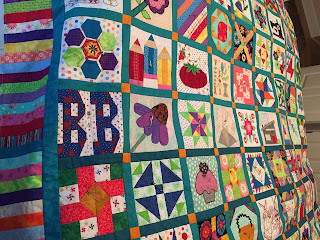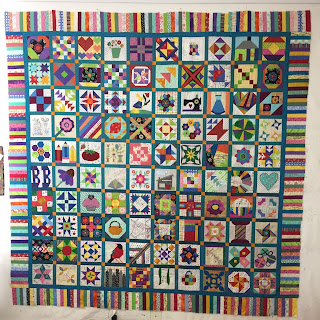If you are going to machine quilt a quilt on your home machine, you need to baste the three layers together. When we hand quilt, we most often baste with thread, large stitches basted in by hand across the surface of the quilt. But with machine quilting you would be sewing in all those threads, then have to remove them, or they would get caught on the presser foot, so thread-basting is not a solution for machine quilting. Most quilters use safety pins:
For a small quilt, I often just use straight pins until the basic grid quilting, like stitch in the ditch, is done. But on a large quilt that wouldn't work: the pins would come out or, worse, you'd get bloody sticking yourself as you manipulate the quilt through the machine.
Here is my process. (I know there are other methods, spray basting, basting guns, etc.--this is how I do it.) First, I need to find a room with tables that will fit my quilt--no crawling around on the floor for me any more. If you have access to a church Fellowship Hall,or a business or community center lunchroom, see if there is a time you can use that space to baste your quilts. After teaching a class this morning at
Patches & Stitches, Huntsville, AL, I put 3 classroom tables together to baste Stella's Splendid Sampler.
The back was pieced from two lengths of fabric, after removing the selvages, then the seam was pressed open. I carefully laid the back out, RIGHT SIDE DOWN. I centered the seam on the middle table. I used small plastic clamps to secure the back to the table, clamping firmly but not stretching the back.If you don't have clamps, bulldog clips, also called black binder clips, often work. At home on my dining room table I use painters tape.
Luckily, most of the back fit nicely on the table, the left and right sides hang over about 6-8":
Then I gently added the batting:
 |
| Twin Size Batting is somewhat larger than needed |
This is my favorite batting. Quilters Dream Cotton batting, Request weight, the lightest. It comes in white or natural, use white if you have a predominately white background:
After smoothing the batting carefully across the back, keeping the left side even with left edge of the back, I spread out the quilt top. This whole process is much easier with another set of hands but it was only me so I did it myself:
An important point: I didn't intentionally center the seam on the center of the quilt--it pretty much happened by accident. For a competition quilt, I would have carefully lined up the center seam of the back with the center of the quilt top. NOTE: For a larger bed quilt, the back would have been made from 3 pieces, about 40" across the middle, and two pieces sewn to either side. OR I would use a wide-goods back, 108" or wider--then you only need the length of your quilt plus a bit for the back. This quilt is 81" square.
How much bigger is the back and batting than the top? If you are quilting it yourself, on a home machine, with a fairly flat/thin batting like this, 4" extra all around is enough--at least 85" in both directions for my quilt. If you are giving your quilt to a longarmer to quilt, they need 8" extra all around, this means, your quilt top plus 4" extra on the left and right sides, 4" extra on the top and bottom edges. The thicker the batting, the more back and batting you need beyond the top.
Once I was satisfied I had the quilt as flat and straight as I could make it, it was time for the safety pins. I was afraid I would run out so I placed them about 7" apart--they really should be closer, about 3-4" apart. As I plan to stitch in the ditch first, on either side of all the turquoise sashing strips, I purposely did not put any pins in the 1" finished sashings. Once the stitch in the ditch is done, I can remove all the rest of the pins to quilt in each block, whatever I think that block needs.
Put the safety pins in BUT DON'T CLOSE THEM, until all the pins are in place. I did run out of pins when I got to the borders, I'll add more once I get home. For now each block has a pin and there are a few in the borders. After ALL the pins are in place, remove the clamps that have been holding the back securely flat on the table:
Now you can close the pins. On a large quilt there can be more than 300 pins and that can be tough on your hands. I used my hands but you can use a grapefruit spoon, a chopstick or a Kwik Klip tool:
Once all the pins are closed, turn it over to the reverse side and check to see if there are any pleats or tucks. If there are, now is the time to fix them. If you forget to fix them, you will sew them in place, just ask me how I know...
 |
| Stella's Splendid Sampler Back |
 |
| Next one in line for machine quilting |
Basting is not my favorite part of the process--having a friend or two to help makes it go faster--but you can do it yourself. If your quilt is larger than the tables you have, after doing the middle portion on the table, close those pins, and slide the quilt to the side, do that side, close the pins, carefully slide the quilt back to the remaining side, and complete the basting. Now you can quilt it!
And it's time to announce the Giveaway for the
Sew-A-Long. The Random Number Generator selected number 2: congratulations, Donna D! We'll get together soon to give you the prizes. Thanks to everyone who posted their photo.
Let's Quilt!
Barbara



















































